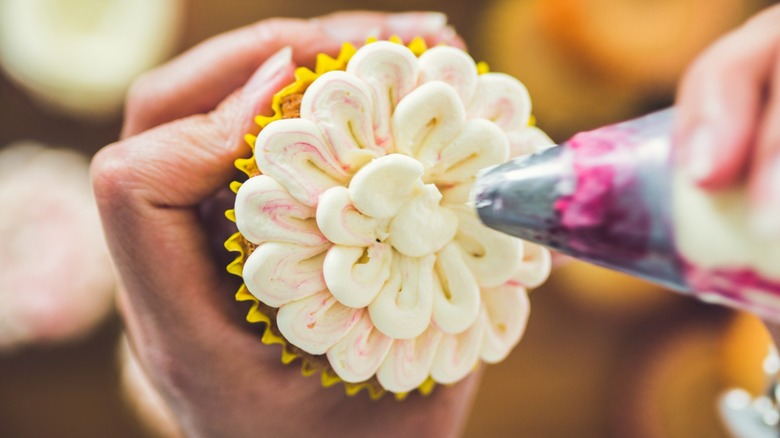The Pantry Staple That Helps Stabilize Homemade Frosting
Awe-inspiring dessert table treats, showstopping bake sale entries, and mile-high holiday marvels often have one thing in common — perfectly piped swirls of delicious frosting. But as a result, nothing will dampen your spirits faster than watching your whipped cream frosting deflate or your buttercream melt. Even with stabilizing ingredients like powdered sugar with cornstarch, most frostings can't take the heat of a crowded room for long — there's a reason many pastry chefs reach for fondant. Luckily for home bakers, there's a pantry staple that can provide substantial stability without drastically affecting the flavor of your frosting: gelatin.
Unflavored gelatin stabilizes your homemade frosting without adding any extra sweetness or overpowering the other flavors. That stands to reason. Gelatin is the key to making homemade ice cream with a luxurious texture. It's what gives three-ingredient marshmallows their structure and bounce. So if your schedule demands you make that cake well in advance of an event or you're worried about your frosting weeping over the course of a long evening, give sturdy gelatin a try.
How to use gelatin in homemade frosting
Gelatin requires a few more steps as you prep your frosting. A process called blooming activates gelatin's stabilizing and smoothing properties. You'll find out the hard way just how important this step is if you add the gelatin powder directly to your mixer. To bloom your gelatin, whisk it into some cold water in a small microwavable bowl until it dissolves and let it sit for a few minutes to solidify. Then melt it by popping it into the microwave for a few seconds until it's liquid.
How much water and gelatin you use depends on your frosting recipe. For example, a standard American buttercream takes a quarter cup of water and 2½ teaspoons of gelatin per 2 pounds of butter. If you're making a whipped cream frosting, start with half a teaspoon of gelatin and a tablespoon of water for every cup of whipped cream.
Incorporating it is really easy. While the gelatin cools, make your frosting as usual. When it has reached soft peaks, stream in the gelatin on low speed. Then finish your frosting as usual. You can refrigerate it for up to five days. Just give the frosting another mix with a whisk before using it. This frosting consistency is perfect for piping and lasts at room temperature for a few hours or more. Just note that if your frosting has cream in it, you have to refrigerate it to avoid spoiling even if the piping is holding.

